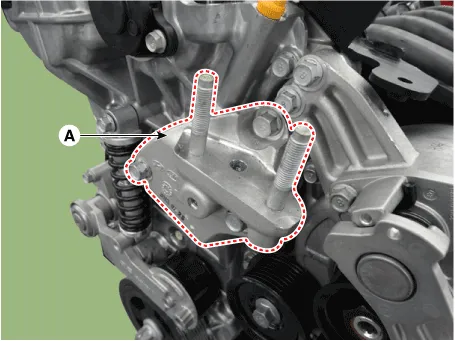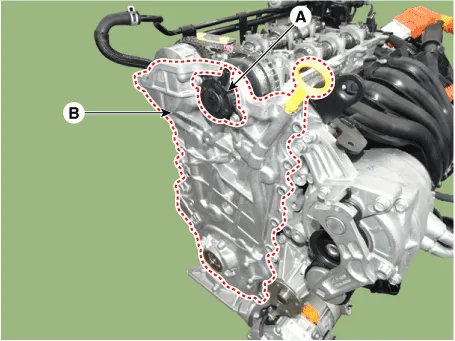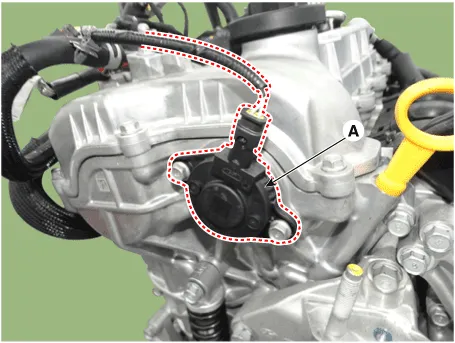Hyundai Ioniq (AE): Timing System / Timing Chain Cover. Repair procedures
| Removal |
|
|
|
| 1. | Shut off the High Voltage circuit. (Refer to General Information - "High Voltage Shutoff Procedure") |
| 2. | Disconnect the battery negative terminal. |
| 3. | Loosen the drain plug, and drain the engine oil. Remove the oil filter cap to help drain the engine oil faster. (Refer to Lubrication System - "Engine Oil") |
| 4. | Remove the air cleaner assembly. (Refer to Intake And Exhaust System - "Air Cleaner") |
| 5. | Remove the RH front wheel. (Refer to Suspension System - "Wheel") |
| 6. | Remove the engine room under cover. (Refer to Engine And Transaxle Assembly - "Engine Room Under Cover") |
| 7. | Remove the drive belt. (Refer to Timing System - "Drive Belt") |
| 8. | Remove the engine mounting support bracket. (Refer to Engine And Transaxle Assembly - "Engine Mounting") |
| 9. | Remove the engine support bracket.
|
| 10. | Remove the drive belt tensioner. (Refer to Timing System - "Drive Belt Tensioner") |
| 11. | Remove the idler. (Refer to Timing System - "Idler") |
| 12. | Remove the crankshaft damper pulley. (Refer to Timing System - "Crankshaft Damper Pulley") |
| 13. | Remove the water pump pulley. (Refer to Cooling System - "Water Pump") |
| 14. | Remove the cylinder head cover. (Refer to Cylinder Head Assembly - "Cylinder Head Cover") |
| 15. | Remove the oil control solenoid (OCS) (A) and then remove the timing chain cover (B).
|
| Installation |
| 1. | Install the timing chain cover.
|
| 2. | Install the oil control solenoid (OCS) (A).
|
| 3. | Replace the front oil seal if necessary. (Refer to Timing System - "Front Oil Seal") |
| 4. | Install the other parts reverse order of removal. |
| 5. | Connect the High Voltage circuit. (Refer to General Information - "High Voltage Shutoff Procedure") |
| 6. | Add all the necessary fluids and check for leaks. Connect GDS. Check for codes, note, and clear. Recheck.
|
Components1. Timing chain cover2. Oil control solenoid (OCS)
Components1. Timing chain2. Timing chain guide3. Timing chain tensioner arm4. Timing chain tensioner
Other information:
Hyundai Ioniq (AE) 2017-2022 Service & Repair Manual: Mode Control Actuator. Repair procedures
Inspection1.Turn the ignition switch OFF.2.Disconnect the mode control actuator connector.3.Verify that the mode control actuator operates to the defrost mode when connecting 12V to terminal 3 and grounding terminal 4.Verify that the mode control actuator operates to the vent mode when connected in reverse.
Hyundai Ioniq (AE) 2017-2022 Service & Repair Manual: General safety information and caution
Safety PrecautionPrecautions To Take Before Servicing High Voltage System • Since hybrid vehicles contain a high voltage battery, if the high voltage system or vehicles are handled incorrectly, this might lead to a serious accidents like electric shock and electric leakage.
Categories
- Manuals Home
- Hyundai Ioniq Owners Manual
- Hyundai Ioniq Service Manual
- Body (Interior and Exterior)
- Fuel Pump Control Module (FPCM). Description and operation
- Fuel Pump Control Module (FPCM). Repair procedures
- New on site
- Most important about car









